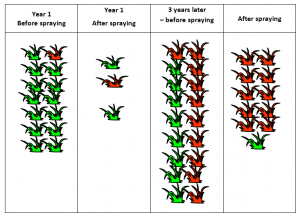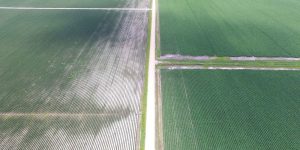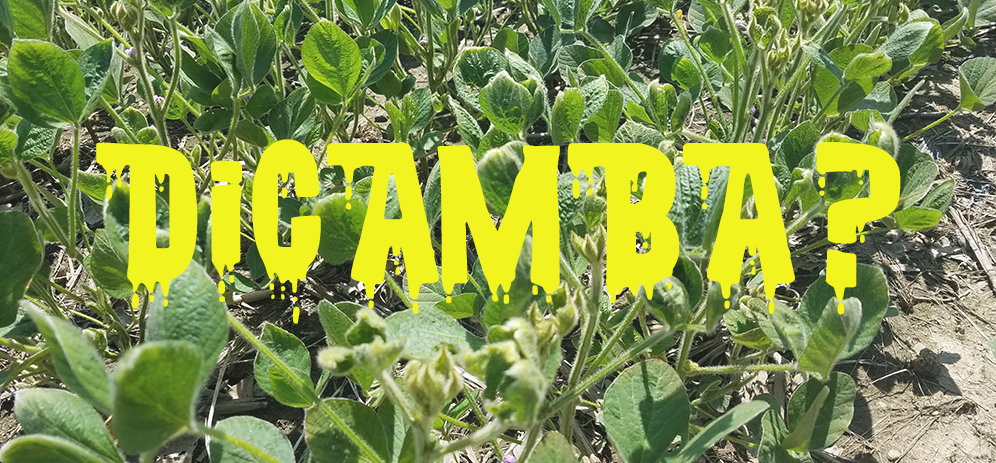Answer — What to do about dicamba?
Larry Steckel is a widely respected extension weed scientist who has worked for 30+ years for the University of Tennessee. He welcomed and enjoyed the wondrous years, 1996 through about 2004, when one or two applications of Roundup worked flawlessly on almost all corn, soybean, and cotton farms.
Since 2005, he has struggled to keep up with grower questions and needs as the spread of glyphosate-resistant weeds has rendered Roundup Ready (RR) technology largely obsolete.
Since 2016, it’s dicamba that keeps Steckel awake at night, leading him to pen a provocative commentary that raises the question — Is dicamba drift and damage the “new normal”?
During the winter of 2012 and most winters since, Steckel has made the rounds of farmer meetings in the Midwest. He has tried his best to deliver corn and soybean growers a blunt message — don’t allow a single glyphosate-resistant weed to go to seed in your fields.
In his presentations, he goes through the brutal math that describes the trajectory of weed resistance in the Southeastern U.S., a problem that starts in most fields with just one, or a few, resistant weeds that escape the farmer’s attention and are allowed to set seed. From then on, regaining control of resistant weeds is near-impossible, and the only way to bring a crop to harvest is to spray, spray, spray.

In a series of truly shocking slides in his 2012 presentation, he projected the annual cost to soybean growers in Iowa if glyphosate-resistant weeds become as widespread as they are now in Tennessee. It’s a big number — $719.9 million!! (For the basis of Steckel’s estimate, see our “In the News” piece “Drifting Dicamba is the ‘New Normal,’ Says Veteran Weed Scientist“).
Not yet ready to accept Steckel’s “new normal” prediction, the leaders of two of the nation’s largest seed companies — Beck’s Hybrids and Stine Seed — have written an unusually forceful letter to the EPA requesting that the agency block any further use of dicamba after the spring spray season. For more details on this surprising development, see “Major Seed Companies in the U.S. Speak Out Against Dicamba.”
Both Stine Seed and Beck’s highlight the adverse impacts of dicamba on rural residents and communities, who increasingly are bearing the brunt of damage from essentially unavoidable off-farm movement of dicamba.
If the EPA puts the Beck’s-Stine Seed recommendation into effect (history tells us this is not likely), the label changes would sharply curtail dicamba use on soybeans and cotton in 2019, and go a long way toward reducing drift and damage episodes.
What Happens Next?
In my four-decade career, I have never seen a cluster of pesticide and pest management technology problems ripen to the point where there seems no way to slow, yet alone stop the bleeding.

By almost all accounts from the field, except those from Monsanto, problems with dicamba volatilization, drift, and crop damage in crop year 2018 have diversified, and in some ways worsened. The drift problem is not going away, despite nearly unprecedented public-private efforts to tighten up label language and educate applicators about the myriad requirements on dicamba-product labels.
Last year (2017), about one-quarter of soybean and cotton acres were planted to dicamba-resistant varieties (about 25 million acres). This year, close to 50 million acres of soybeans and cotton were sown to dicamba-resistant seeds, and next year, the total will likely approach 70 million acres.
70 million acres is over one in five cropland acres nationwide. Almost everyone living within 20 miles of a major Midwestern or Southeastern farming area will see changes in the plants and trees in their neighborhood, and as they drive along rural highways in corn, soybean, and cotton country.
The good news — a shrinking portion of the nation’s soybean and cotton crops will be vulnerable to dicamba drift damage in 2019 (because so many acres are planted to dicamba-resistant varieties).
The bad news — a higher percent of the not-dicamba resistant soybean and cotton crop in 2019 will be damaged, and the damage will be more serious in some areas.

Plus, damage to trees, speciality crops, backyard gardens, and ornamental plantings will also spread, and likely worsen. Moreover, research shows that dicamba-drift damage can erode the health and vitality of mature trees and vines incrementally over three to five years, ultimately leading to death from one or several causes that might seem unrelated to dicamba drift.
In crop year 2018, the major biotech and seed companies that control the majority of the soybean and cotton seed supply moved the dicamba-resistance gene into most of the nation’s soybean and cotton seed supply. This seed will be planted in 2019 even if EPA ends post-emergence dicamba applications, because there is no way to pull the dicamba-resistance gene out of seed grown in 2018, nor is there an alternative source of seed in sufficient quantities to plant the U.S. crops.
Farmers will pay a premium of around $15 per planted acre when they purchase seed with the dicamba trait. Most will take advantage of the trait by spraying dicamba at least once after their crops has germinated, and some will spray dicamba twice. The second spray, later in the season when hot and humid weather is hard to avoid, is when the risk of volatilization, movement and damage is greatest.
Production costs will rise on these farms, eroding competitiveness. Drift and damage will worsen. Public health risks will rise markedly, especially reproductive risks and birth defects.
Weeds already resistant to dicamba will spread, and new ones will move along the continuum of slipping efficacy on the path to full-blown resistance.
Environmental impacts will be more evident and serious.
As the effectiveness of dicamba slips, the seed-biotech industry will provide farmers new seeds genetically engineered to tolerate post-emergent applications of four, or six or more herbicides, on the theory that the only way to help farmers manage through current the crises triggered by the spread of resistant weeds is to do more of what caused the problem in the first place.
Dicamba’s Day of Reckoning

The next “day of reckoning” will come with the EPA’s announcement this fall of whether or not the agency will extend the time-limited, conditional registration of all post-emergence dicamba herbicide labels.
Given that the dicamba-resistance gene is already in the majority of the soybean and cotton seed supply available to plant these crops in 2019, it seems unlikely that the EPA will end the post-emergence use of dicamba in 2019.
If they did, the EPA would be re-setting the stage for a replay of the problems experienced in 2016, a season when farmers bought, planted, and sprayed dicamba-resistant crops with dicamba, despite there being no dicamba-herbicide labels allowing such applications.
Instead, the EPA will likely tighten up some already complex and hard to comply with restrictions on when and under what circumstances dicamba can be sprayed.
If the EPA decides it must act to reduce the scale of the problem in 2019, they will likely lower the maximum application rate, limit farmers to no more than two applications, and cut by about one month the time period during which applications can be made.
Taken together, these changes, if adhered to, should curtail many of the highest-impact episodes of volatilization, movement, and crop damage, events that usually occur in the heat of summer. These changes would still allow farmers to use dicamba in their efforts to gain early-season control of most glyphosate-resistant weeds.
Such changes will totally satisfy no one, and are not real solutions to the very serious weed management problems confronting many U.S. farmers.
But such tinkering-at-the-margins of this problem is likely the only way to reduce somewhat the magnitude of a very serious problem that now unites the world’s largest pesticide-seed-biotech company, Bayer AG, with the U.S. EPA, GE crop farmers and their neighbors, and the nation as a whole. Stay tuned for what comes next.


7-8 years ago I could furnish the neighborhood with tomatoes,bell pepper, from a small garden in my backyard in a rural neighborhood in Murfreesboro NC. Now I can hardly get enough to make a tomato sandwich The leaves look identical to the problems associated with dicamba . I’ve taken soil samples tried everything I know and information from experts. Several have told me it’s coming from herbicide drift. After fighting this problem and going downhill for the last 6-7 years I’m ready to give up on gardening
Richard — I sure hope you don’t give up gardening. One strategy, until you definitively figure out what has been causing the problems, is to plant more heavily veg crops not as sensitive to dicamba and 2,4-D drift, and avoid those that are highly sensitive. I don’t have a list handy, but that is a good task for us to take on. Another good first step is to figure out what herbicides are likely used on substantial acreage within 1 mile of your farm/garden. I am sure you know the top 3 or 4. Then, you can go to the Pesticide Use Data System on Hygiea, select those crops and “North Carolina”, and see what the most widely used herbicides have been in recent years.
For example, if you pick corn as the crop; and under “Select Pesticide Group” you pick “Herbicides”; pick North Carolina under “Select State/Nation”; and, 2016 as the year, you will see that atrazine was the most widely used herbicide (71% of corn acres treated, and not likely the source of your problem), but 27% was sprayed with 2,4-D, a highly volatile herbicide, and possibly the source of the damage you have been experiencing. Another solid step, although sometimes not a comfortable one, is to ask neighboring farmers what herbicides they have applied on the fields near you.